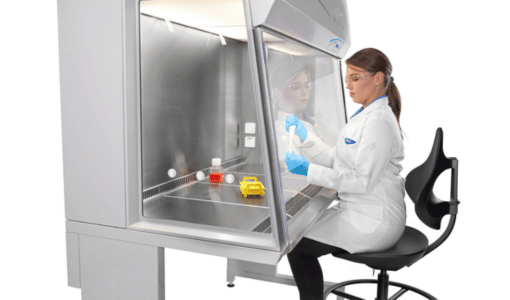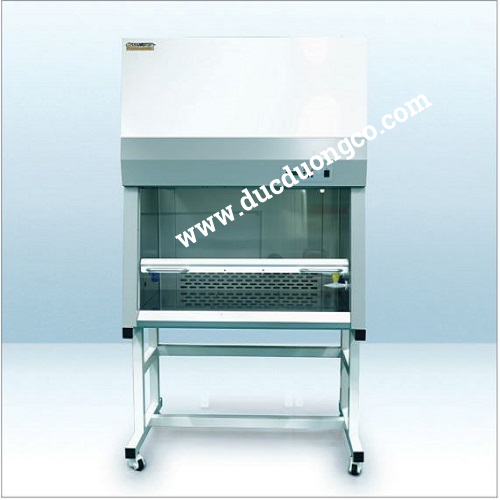Biological Safety Cabinets in Laboratory - Applications, Benefits
Biological safety cabinets play a crucial role in laboratories, especially those working with microorganisms, fungi, and other biological agents. They act as a protective shield, creating a sterile environment for safely handling specimens and protecting users from infection risks.
A. The Importance of Biological Safety Cabinets in the Laboratory
- Protecting Specimens: Biological safety cabinets prevent the intrusion of external microorganisms, ensuring the purity and accuracy of experimental results.
- Protecting Users: Effective air filtration systems remove harmful bacteria and viruses, minimizing infection risks for users.
- Protecting the Environment: They limit the release of microorganisms into the surrounding environment, contributing to public health protection.
- Enhancing Experimental Efficiency: The sterile environment allows for more precise and reliable work, reducing the risk of experimental failure.
- Cost Savings: Prevents contamination of specimens, saving time and money on subsequent experiments.

B. History and Applications
- History:
- 19th Century: The precursor to biological safety cabinets was simple enclosed chambers with ventilation systems.
- 20th Century: Modern biological safety cabinets were developed with more effective air filtration systems, using HEPA and ULPA filters.
- Today: Biological safety cabinets are equipped with advanced features, automation, and integrated new technologies.
- Applications:
- Microbiology: Cultivating microorganisms, conducting microbiological experiments, handling biological specimens.
- Medicine: Medical microbiology research, diagnosing infectious diseases, producing vaccines and biological drugs.
- Pharmaceuticals: Quality testing of raw materials, sterile drug production, research and development of new drugs.
- Agriculture: Studying soil microorganisms, seed quality testing, producing biological products.
- Food Industry: Testing food safety, researching microorganisms in food, producing functional foods.
.png)
II. Benefits of Biological Safety Cabinets
Biological safety cabinets offer practical benefits for laboratories, especially in microbiology research, medicine, and production. Here are some key benefits:
A. Protecting the Experimental Environment:
- Eliminating Microorganisms: Effective air filtration systems remove up to 99.97% of harmful bacteria and viruses from the air, creating a sterile environment inside the cabinet.
- Minimizing Cross-Contamination: Prevents the spread of microorganisms between specimens, tools, and users, ensuring the accuracy of experimental results.
- Controlling Humidity and Temperature: Creates an ideal environment for the growth of certain microorganisms, enhancing experimental efficiency.

B. Ensuring Biological Safety:
- Protecting Users: Prevents direct contact with hazardous microorganisms, reducing the risk of infections via the respiratory tract, skin, and eyes.
- Protecting Specimens: Prevents external microorganisms from contaminating specimens, ensuring research purity and accuracy.
- Limiting Disease Spread: Minimizes the risk of spreading dangerous infectious diseases into the environment.

C. Increasing Work Efficiency:
- Improving Accuracy: A sterile environment allows for more precise and reliable work, reducing errors caused by contamination.
- Saving Time and Costs: Avoids waste from contaminated specimens, saving time and money on subsequent experiments.
- Increasing Productivity: A safe and efficient environment helps users focus and complete tasks more quickly.
.png)
In addition to these benefits, biological safety cabinets also offer other advantages such as:
- Ease of Use and Maintenance
- Space Efficiency in the Laboratory
- Aesthetic Enhancement of the Laboratory
Biological safety cabinets are essential for any laboratory working with microorganisms. They provide numerous practical benefits, contributing to safety, efficiency, and success in scientific research.
III. Types of Biological Safety Cabinets
Biological safety cabinets are classified based on two main criteria: function and brand.
A. Classification by Function:
-
Horizontal Laminar Flow Biological Safety Cabinets:
The air flow is directed from the back through the working chamber horizontally, creating a protective barrier for users and specimens. This type is the most common and suitable for various applications.
.png)
-
Vertical Laminar Flow Biological Safety Cabinets:
The air flow is directed from above downward through the working chamber, providing a more effective sterile environment. This type is often used in applications requiring high safety, such as handling hazardous microorganisms.
.png)
B. Classification by Brand:
Several reputable brands of biological safety cabinets are trusted by laboratories both domestically and internationally. Notable brands include:
-
SJ Clave - Korea: Leading brand for autoclaves and other laboratory equipment from Korea.
-
LK Lab - Korea: Provides basic laboratory equipment.
-
LaboGene: Korean brand offering cost-effective biological safety cabinets with good quality.
Note:
Choosing the appropriate biological safety cabinet depends on usage needs, budget, and laboratory space. Consulting with experts is recommended for selecting the most suitable product.
IV. How to Choose a Biological Safety Cabinet
A biological safety cabinet is a significant investment for any laboratory. Selecting the right type will ensure safety, efficiency, and success in scientific research. Here are some steps for choosing a biological safety cabinet:
A. Selection Criteria:
-
Determine Usage Needs:
-
Type of Microorganisms: Size, characteristics, and contamination risks of microorganisms.
-
Purpose of Use: Specific tasks to be performed in the cabinet.
-
Laboratory Size: Space and layout of the laboratory.
-
Budget: Costs of various types of biological safety cabinets.
-
Choose the Suitable Type:
-
Horizontal Laminar Flow Biological Safety Cabinets: Suitable for various applications.
-
Vertical Laminar Flow Biological Safety Cabinets: Higher safety for hazardous applications.
-
Determine Required Features:
-
Air Filtration System: Efficiency of dust, bacteria, and virus filtration.
-
Airflow Rate: Ensures adequate air supply to the working chamber.
-
Airflow Speed Control: Allows adjustment of airflow according to needs.
-
Lighting System: Ensures good visibility inside the working chamber.
-
Working Surface: Easy to clean and disinfect.
-
Working Chamber Size: Fits the usage needs.
B. Evaluate and Compare Products:
-
Consult Experts: Discuss with scientists, technicians, or reputable suppliers for product recommendations.
-
Compare Specifications: Review features, performance, and prices of different cabinets.
-
Read Product Reviews: Check user reviews on reputable websites.
-
Contact Suppliers: Inquire about warranty policies, after-sales service, and request quotations.
C. Recommended Models for Authentic Biological Safety Cabinets:
-
LM-1800V Biological Safety Cabinet
-
Sterile Environment: Removes dust affecting experiments.
-
Airflow Direction: Vertical from top to bottom.
-
HEPA Filter: 99.97% filtration efficiency.
-
Airflow Control: 10-step adjustment.
-
LCD Display: Monitors operation status, filter replacement alerts, and displays.
-
Tempered Glass Door: Counterweight.
-
Working Surface: Stainless steel.
-
UV and Fluorescent Lighting: Operate alternately, auto-off when the door is open.
-
Easy Filter Replacement: At the front.
-
Internal Dimensions: w1360×d550×h670 mm
-
External Dimensions: w1500×d700×h2100 mm
-
Display: LCD
-
Main Filter: HEPA filter 0.3µm 99.97%
-
Secondary Filter: Nylon filter
-
Interior Material: Stainless steel 304
-
Exterior Material: Coated steel
-
Fluorescent Light: 40 W×1EA
-
UV Light: 40 W×1EA
-
Timing: 99 hours 59 minutes
-
Airflow Speed: 0.3-0.5 m/s
-
Power Supply: 1-phase 220V/60Hz
View Details: LM-1800V Biological Safety Cabinet
D. Where to Buy a Biological Safety Cabinet?

DEUC DUONG TECHNICAL SCIENTIFIC COMPANY LIMITED specializes in providing equipment and furnishings for laboratories.
As science and technology advance, the demand for applying technology in practice is increasing. Consequently, laboratories, research centers, and scientific institutes are continually improving to keep pace with scientific and technological development.
With a team of experienced engineers passionate about their work, we are ready to address all customer inquiries.
Deuc Duong continues to provide optimal solutions and high efficiency for laboratory usage.
Our company is increasingly establishing its brand and reputation in the field of laboratory equipment and environmental technology.
Contact us today for advice: [Contact Information]
Or reach us at the hotline below:
-
Address: 1014/67 Tan Ky Tan Quy, Binh Hung Hoa, Binh Tan, HCM
-
Tel: (028) 3762 8042 - 3762 8043 - 3750 8514 - 3750 8793
-
Fax: 028 37628043
-
Email: ducduong@ducduongco.com
-
Website: www.ducduongco.com
Choosing the right biological safety cabinet depends on usage needs, budget, and thorough evaluation criteria. We hope this information helps you make an informed decision when purchasing a biological safety cabinet for your laboratory.
V. Using Biological Safety Cabinets
A biological safety cabinet is a crucial laboratory device; however, incorrect usage can affect work efficiency and safety. Here’s how to use a biological safety cabinet properly:
A. Correct Usage Procedures:
-
Preparation Before Use:
-
Wear lab coat, gloves, mask, and protective hat.
-
Disinfect the working surface inside the cabinet.
-
Ensure that the cabinet is installed on a stable surface, not near doors, windows, or air vents.
-
Check air filters for cleanliness.
-
Using the Cabinet:
-
Place specimens, tools, and materials in the working chamber.
-
Avoid touching the cabinet's sides or back.
-
Operate the cabinet with the door closed.
-
Use laminar airflow properly to minimize contamination risk.
-
During and After Use:
-
Avoid touching the interior with bare hands.
-
After use, disinfect the working surface and all items.
-
Close the cabinet door while the UV light is on to ensure disinfection.
-
Ensure the cabinet is properly cleaned and dried before the next use.
B. Maintenance and Care:
-
Regular Cleaning: Clean the working surface with appropriate disinfectants.
-
Filter Replacement: Follow the manufacturer's instructions for filter replacement.
-
Routine Checks: Regularly check the cabinet's performance and functionality.
C. Troubleshooting Common Issues:
-
Cabinet Does Not Start: Check power supply and electrical connections.
-
Inconsistent Airflow: Inspect and replace air filters if necessary.
-
Leakage or Damage: Contact the manufacturer or supplier for repair or replacement.
VI. Conclusion
Biological safety cabinets are essential for maintaining a sterile environment and ensuring safety when handling biological specimens. Understanding their types, benefits, and proper usage will help you select and use a suitable biological safety cabinet effectively. Regular maintenance and proper usage will maximize the cabinet's efficiency and extend its lifespan.




